
16 minute read
Caveat emptor
An exploration of how to choose a shipyard
BY RORY JACKSON
TSG talks to a broker, an owner’s representative and a lawyer to ascertain how clients should approach choosing the right shipyard.
Excellence is the accepted quality standard in the superyacht industry – but not all shipyards are equal. Those looking to commission new builds should consider a number of factors before engaging in a build contract. How financially stable is the yard? How efficiently are they managing their current projects? Is the pricing fair? How should the relationship with the shipyard be managed?
“The first consideration is to understand the balance between what the client’s expectations are on quality and what their budget might be,” says Will Christie, founder of Christie Yachts. “Generally, I will try and persuade clients to go for as high a quality as possible, and maybe give up a bit on the size, because living with a superyacht that isn’t great quality really isn’t a fantastic experience for any owner.
“A further consideration is the resale value of a project. Brokers are acutely aware of how easy or how difficult it can be to sell a boat after a few years when the owner inevitably decides to move up in size or, occasionally, move away from yachting altogether. We can steer them towards features that will increase resale value and advise on any that will make resale more challenging. Building a custom superyacht is the ultimate luxury as you get exactly what you want but when you make the decision to move on, you want to end up with a product that you can also sell without losing your shirt. That can come down to interior design, the layout, number of cabins etc.”
Ultimately, when buying a superyacht, clients are paying for quality and, to a certain extent, they are also paying for the brand. Christie explains that when it comes to a second-hand sale, the last thing a broker wants to be doing is first having to convince a buyer to consider the product of a lesser known yard, although it is always possible. Indeed, in instances where the brand name and pedigree are immediately recognisable, at least part of the job is already done for the broker. There is always a ready market for yachts from those recognisable, pedigree yards.
“Most clients do a quick 10-second analysis when they see a boat for sale. They look at the length, the yard, the delivery year and the price and, unless they are completely new to the market, they will be able to make a decision quickly as to whether or not they are interested in a vessel,” adds Christie. “It takes a highly skilled broker to sell a superyacht that comes from a yard without an established brand. That being said, it is perfectly possible to commission a successful superyacht project at a less established shipyard but the onus is then on the owner to create a team that has sufficient experience and expertise to account for the areas in which the shipyard might be lacking.”
To illustrate Christie’s point, a previous Feadship owner was able to put together a team of established designers, naval architects and project managers, all of whom with experience of established yards in Northern Europe, and in doing so completed a very highquality project without the associated premiums of Northern Europe at a less established Southern European shipyard. Indeed, even the subcontractors used typically worked with the Northern European yards and the interior came from Germany. However,
Will Christie, founder, Christie Yachts.
Giovanna Cabbia, shipping lawyer, Clyde & Co.
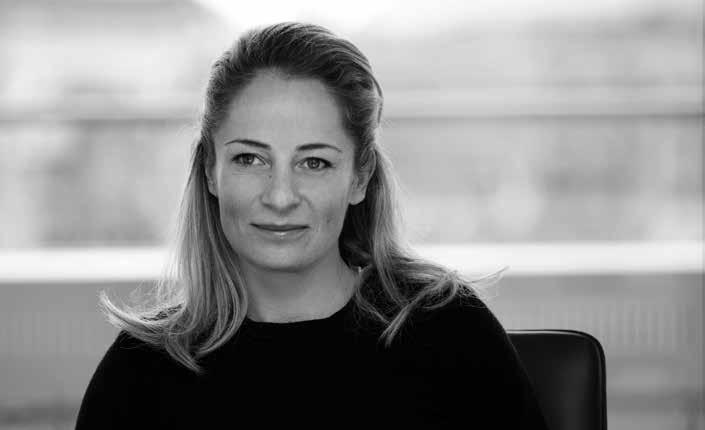
getting a client to view the vessel when it came on to the market still took a great deal of persuasion and Christie maintains that clients, by and large, will get what they pay for when it comes to quality, brand and resale value, but with the right team you can get good quality at a lower price. “Building the right team is vital to choosing the right yard because due diligence on any yard is incredibly important,” says Derek Munro, owner’s representative and director at Divergent Yachting. “This process is helped a lot by having the right brokers, lawyers and wider team in place. What is the history of the shipyard like? How well financed is the yard? How stable has the yard’s order book been? How often has the yard changed hands?
“The more questions that need to be asked, the more research needs to be done. That being said, it is absolutely possible to build a good quality superyacht at a shipyard with some question marks provided the team and the specification is right. Ultimately, everyone is complying to the same codes, classification requirements and everything else. The machinery is all built by the same people. How you write your spec and monitor the build is vital.”
While legal assistance has always been a vital part of any superyacht transaction, in recent years the growing size and complexity of superyachts – and indeed the requisite contracts – has necessitated that the legal support has become an increasingly engrained part of every new-build transaction. Indeed, the market’s top legal professionals are widely considered to be some of the industry’s most important advisors.
“Clients should seek advice at an early stage of commercial discussions,” explains Giovanna Cabbia, shipping lawyer at Clyde & Co. “Even at the stage of a letter of intent, legal counsel is able to set out the main boundaries of the contract before beginning the next stage of the process.
“In terms of choosing the shipyard there are two prerequisites. Does the shipyard have the skills and experience to build the specific type of yacht you have in mind and have you considered the financial standing of the shipyard and the extent to which the buyer will be protected should something go wrong? Can the buyer get their money back if the shipyard is unable to complete the build, in the event that the yacht doesn’t comply with the contract or if there are major defects in performance?”
Cabbia explains that while it is absolutely possible, and indeed essential, that one carries out various financial checks on a shipyard, the yard’s books may not necessarily yield all the answers. Historical performance and financial records will, for instance, not be able to tell a buyer whether or not there are any issues with ongoing projects, if there are outstanding liabilities on the shipyard, if there are third-party claims against the yard or if the yard is up to date with payments to its suppliers or subcontractors. “It is always worth checking with other people in the industry, whether that is subcontractors, owners, project managers or another knowledgeable stakeholder that is working at or with the yard, to determine how the builder is performing towards its other contracts,” adds Cabbia.
The superyacht industry is a small one, and for people in the know it shouldn’t take long to determine how healthy a particular shipyard’s opera-
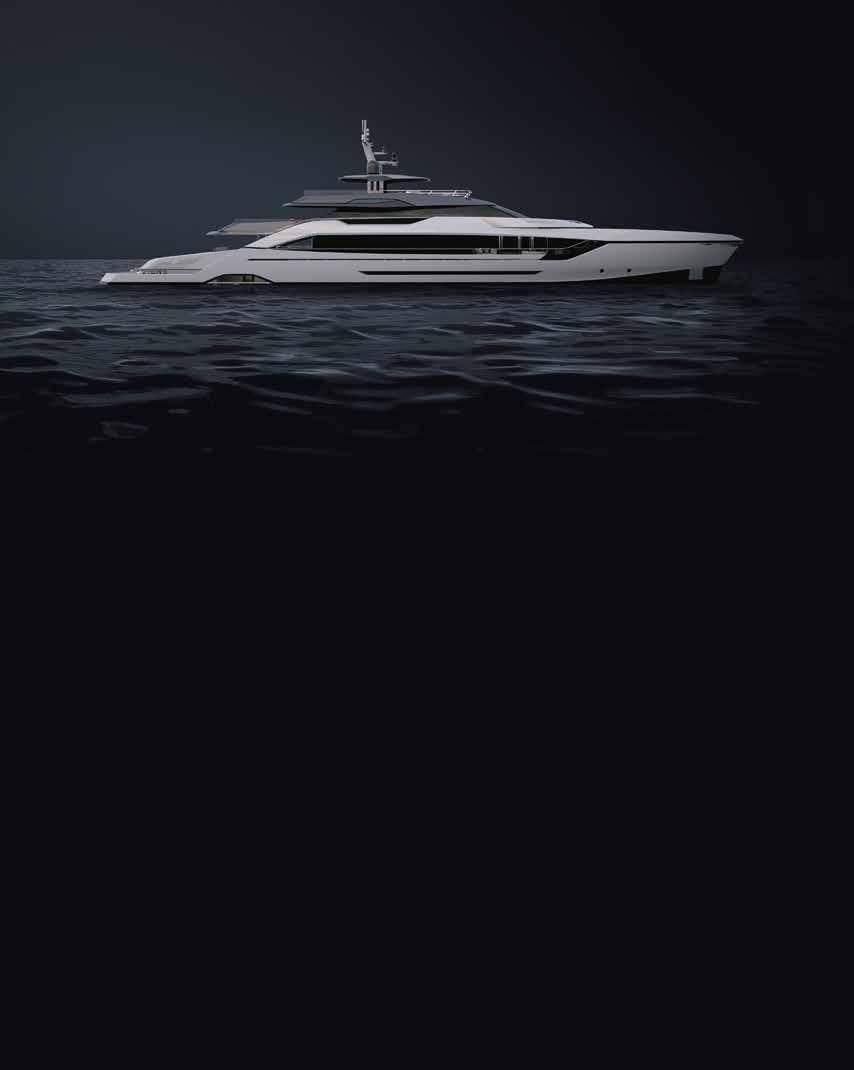
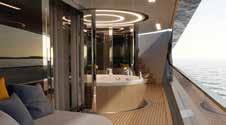
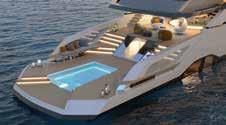
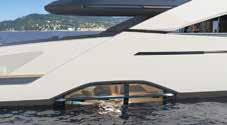
83m Here Comes The Sun, launched from a Damen Yachting facility.
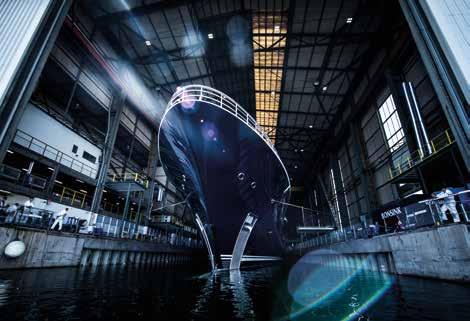
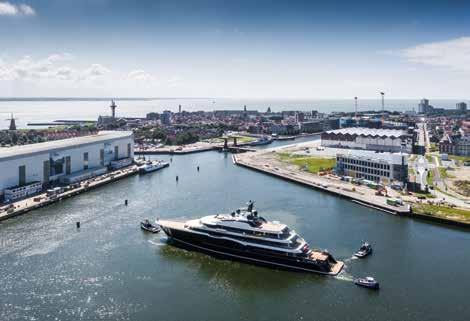
Tom van Oossanen
Tom van Oossanen tion is at any given moment. A few pointed questions asked in the right direction will typically be incredibly elucidating.
“There have definitely been shipyards in recent times where, if you did a little bit of due diligence, you’d quickly find out that subcontractors weren’t being paid,” says Christie. “Another great way to determine how financially healthy a shipyard is to ask what bank guarantees can be provided against initial payments because until you actually have a hull that can be towed away and finished elsewhere, essentially you just have a piece of paper [the contract] and you may have paid 10 per cent of the contract price up front for the privilege with nothing to show for it. If a shipyard can’t offer a bank guarantee it may be that they are unable [to] or that they would prefer to use another system but it is an initial question worth asking.”
It could be the case that the shipyard would prefer to use a parent-company guarantee, as might be the case with shipyards with large commercial parents such as Damen and Lürssen, given that refund guarantees provided by banks do incur an additional cost to the shipyard. Alternatively, the shipyard may have such a vibrant order book that a further guarantee is not required. However, in instances where question marks remain over a shipyard’s financial security or the performance of its order book, a refund guarantee comes highly recommended.
“Most of the large yards today are capable of providing refund guarantees, but in the case of smaller yards that only build a few projects a year and that don’t have the credit line to support a guarantee, there might be other ways to
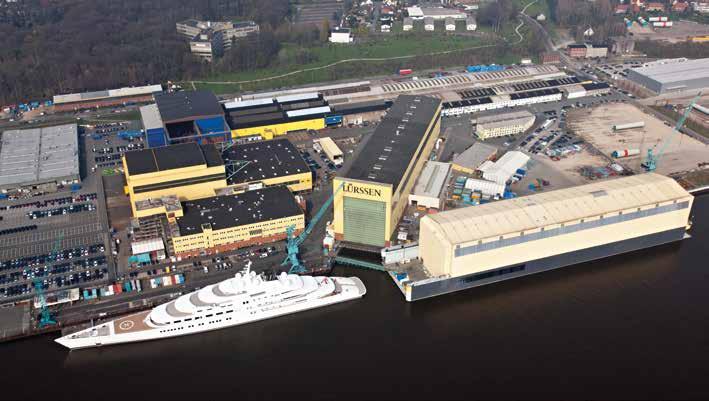
180m Azzam at Lürssen’s facility in Bremen. negotiate the contract in a protective way for the buyer,” says Cabbia. “This may, for instance, be achieved by negotiating a more favourable payment schedule so that very little is paid upfront until there is some value in the build that can be secured by a progressive transfer of title, or cash that is put into escrow until there is a vessel that is registerable as a construction.”
However, the issue with stage payments is that one must be wary of squeezing a shipyard too tightly on the provision of payments and a project’s eventual margin. Superyachts are expensive to build and typically require significant upfront payment to get the project off the ground. Subcontractors, for example, need deposits before they are able to start working and placing orders. Cash flow for a shipyard can be difficult and if they are pushed too hard on price to the extent to which the margin is prohibitive from the yard’s perspective, it’s likely that the buyer will pay for the hard negotiating tactics when it comes to variations to the contract.
“If you push a yard really hard on price then you will probably pay for it later because every time they can see opportunity to request a variation to the contract (VTC)/change order, they will do so,” says Christie. “There is a balance between working towards a good deal and pushing the yard so hard that the project will no longer be financially viable for them. If they are losing money, they will try and find a margin during the build by pushing you with VTCs for even the smallest changes.”
Munro adds, “We all want the shipyards to survive for the simple reason that we want them to be there to give us our warranty. But not only that, we want them to be there so that when the broker comes to resell the boat, he can talk about a shipyard that is in existence and a vessel that has come from that yard.
“It benefits everyone if the shipyards make money. If you are fighting them throughout the whole project, regardless of how much of a spec review you do, there will be VTCs at some point and probably a number of them. You’re going to need these people for the lifecycle of your yacht ownership and therefore you want to negotiate fairly.”
In order to ensure that a build at any given shipyard runs as smoothly as possible, it’s always advisable to engage in amicable negotiations. Indeed,

Derek Munro, owner’s representative and director, Divergent Yachting. Munro concedes that in years gone by owners’ representatives and various other owners’ team members were perhaps too confrontational with shipyards. As with the pricing pressure and the inevitable addition of VTCs, confrontational negotiations will lead to a souring of the relationship between shipyard and owner’s team before the project has even really got off the ground.
“Good open communications are paramount. After all, we are all working towards the same goal – a great vessel for the client,” he says.
Christie recalls a time when he was working on behalf of an owner for a large custom project. During the build, he became aware of another project that was being completed at the same yard at the same time in an altogether different working environment. “We did a project while there was another project at the same yard being run by another team. I know for a fact that they were getting a lot of VTCs that we weren’t and the reason was because the owner’s team had been so belligerent the whole time that the shipyard had just had it to the back teeth with them.
“Whereas with us they were letting minor VTCs go as we were working with them, not against them. Every project will have heated moments, but you need to choose your battles as it’s a three- to four-year process. Large custom projects in particular are never smooth sailing and sometimes you will have to really fight for your client, but there are ways of approaching disagreements constructively. If you go in spoiling for a fight when a fight isn’t necessary, you’ll pay for it. Ultimately, everyone involved wants the same outcome – a happy owner – so it’s best to work together towards that common goal.”
It’s also important to be wary of the willingness on the part of a shipyard to lower their prices and please the client. If certain shipyards quote prices that are significantly lower than their competitors, one has to question why there is such a steep price differential. Is it that the shipyard is inexperienced and simply doesn’t know what a project should cost or is the shipyard desperate for business? Either way, low pricing should always be a red flag.
While the focus here has been on yard pedigree and performance, one must also be wary of who the client is when deciding which shipyard to choose. Does the client have the necessary wealth profile to afford a particular type of vessel? If they can afford the initial capital outlay, are they aware of the continued running costs?
It’s all well and good highlighting the world’s top shipyards and encouraging people to choose quality, to be wary of financial red flags and so on, but at the end of the day it entirely depends on what people can afford. Nevertheless, the creation of a strong owner’s team and sufficient due diligence can go a long way to ensuring clients choose the right shipyard. RJ
DO YOU WANT TO KNOW MORE? VISIT SUPERYACHTNEWS.COM AND SEARCH ‘SHIPYARDS’
A route to a greener future
Baltic Yachts has seized the sustainability initiative in its implementation of processes and practices that resonate across every element of its operation …
Sustainability and a greener future are integral to growth and success, as Anders Kurtén, CEO of Baltic Yachts, conveys, “Any part of the industry which doesn’t take sustainability seriously doesn’t have a future; it is that simple”. With this in mind, Baltic Yachts has set about defining and working towards its own sustainability targets, but as Kurtén explains, defining the targets themselves is the first hurdle to be overcome. “One of the challenges that come with setting a high standard for the environmental aspects of production is that there is no sustainability standard to measure from.” As Kurtén continues, “We decided about three years ago, given the absence of such a standard, that we would apply our expertise and experience and decide on our own set of parameters from which to measure and quantify our progress.”
The critical differentiator for Kurtén and the team at Baltic Yachts is the willingness to engage with the smaller, less headline-grabbing changes that need to be made. Sustainability solutions, very often, are greater than the sum of their parts, as Kurtén explains the philosophy further. “It is a trickle of multiple small streams that pull together to contribute something greater. There may be this frustrating sense that there is no ‘silver bullet’; however, the industry must keep track of these small contributing influences. The positive being that many of them are very easy to change, it just requires a focus and cultural shift.”
Baltic Yachts have implemented a series of sustainability solutions across its shipyards, and by its own high standards have made significant positive steps towards sustainability. Baltic Yachts has recently converted all power consumption to locally generated windfarm and hydroelectricity, with all fossil fuel generators replaced by organic, bio-pallet heating systems. Baltic has also reduced unsorted waste to zero and also reduced the waste per labour hour by over 10 per cent.
Baltic Yachts are also pioneering the use of more complex technologies. One of which ironically draws on a natural solution steeped in maritime tradition: flax, as Kurtén explains further, “We are delighted to have launched the 68ft Café Racer, which to our knowledge is the largest boat that has ever been built where flax has structural properties; in over 50 per cent of the hull and structures we have substituted carbon fibre for flax.” When asked about the potential for this green solution on larger superyachts, Kurtén and Baltic Yachts are ready. “There is no technical obstacle to scaling this up to a 100-foot superyacht, we just need the right project. We believe it is only a matter of time before the right combination of owner and circumstances will align and we can implement this technology on a larger scale.”
The presumed un-recyclability of GRP (glass reinforced plastic) vessels has long been an inconvenient truth of the yachting industry, and the end-of-life process for these yachts is usually to be resigned to the scrap heap. With Baltic’s pioneering use of carbon fibre for a generation, it was natural to see the re-proposing of carbon as a sustainability standard that they can adopt. As Kurtén explains, while nascent, these technologies will likely play a crucial part in a sustainable future. “There is another really promising technology, which is not quite there yet, but it looks extremely promising: recycled carbon fibre through solvolysis, and reversing the lamination process.”
Baltic Yachts will keep driving their sustainability targets forward because, as Kurtén explains, “Sustainability, as a term, is evolving and is more than a simple PR exercise. When talking about sustainability and superyachts, it has transitioned from being an interesting icebreaker at a cocktail party with clients, influencers and gatekeepers. Now the world has changed to such an extent that it’s a genuine competitive advantage, as well as an environmental imperative.”











